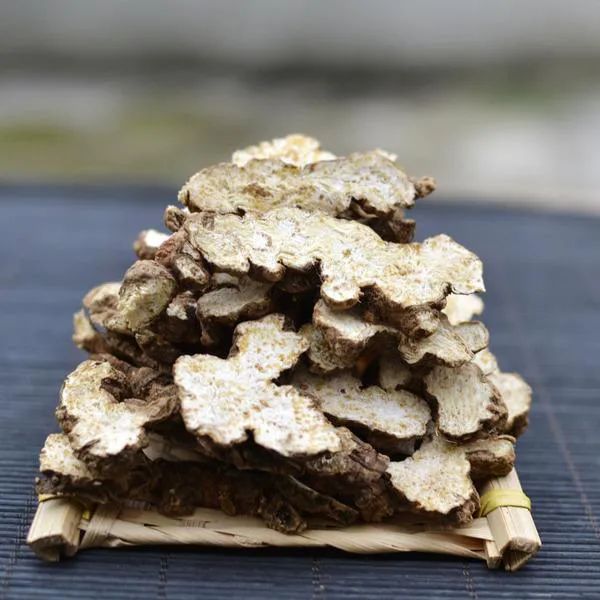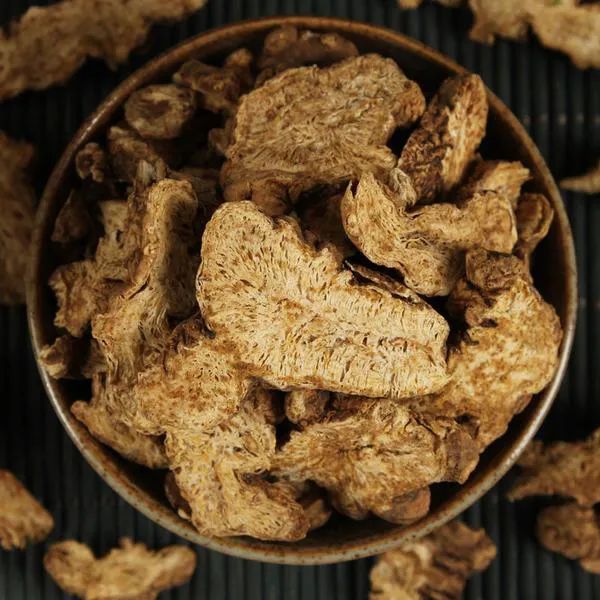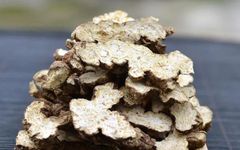 Click the blue text above and remember to follow us!Strengthens the spleen, dries dampness, and dispels filth. It treats excessive dampness obstructing the spleen, abdominal distension, loss of appetite, vomiting, diarrhea, malaria, and seasonal colds.According to the Compendium of Materia Medica: “[Zhenheng] states: Cang Zhu treats dampness, applicable to the upper, middle, and lower parts… Therefore, Cang Zhu is a medicine for the Foot Yangming Meridian, with a pungent and strong flavor, it strengthens the stomach and spleen, and promotes the qi of grains.”
Click the blue text above and remember to follow us!Strengthens the spleen, dries dampness, and dispels filth. It treats excessive dampness obstructing the spleen, abdominal distension, loss of appetite, vomiting, diarrhea, malaria, and seasonal colds.According to the Compendium of Materia Medica: “[Zhenheng] states: Cang Zhu treats dampness, applicable to the upper, middle, and lower parts… Therefore, Cang Zhu is a medicine for the Foot Yangming Meridian, with a pungent and strong flavor, it strengthens the stomach and spleen, and promotes the qi of grains.”

Antimicrobial Effects of Cang Zhu
Cang Zhu is one of the important medicinal materials in ancient China for disease prevention, possessing air disinfection, antimicrobial activity, antiviral properties, and insecticidal effects.Pharmacological studies have confirmed that Cang Zhu exhibits activity against cocci, bacilli, fungi, and viruses. Using Cang Zhu for fumigation can disinfect indoor air, achieving or exceeding the effectiveness of ultraviolet irradiation, with a longer duration of bacterial colony elimination.
-
Experiments aimed at isolating antimicrobial compounds from Cang Zhu, using methanol cold extraction, ultimately identified seven compounds and determined their structures. Antimicrobial activity tests were conducted on these seven compounds using HeLa cells to assess cytotoxicity. The seven compounds were identified as Compound I (Di-n-pentyl phthalate), Compound II (Atractylodes lactone IV), Compound III (Atractylodes enol lactone III), Compound IV (Oleic acid), Compound V (4E, 6E, 12E)-tetradecatriene-8,10-diyne-1,3-diol-diacetate, Compound VI (Atractylodes lactone I), and Compound VII (β-Sitosterol). Antimicrobial tests against 23 bacterial strains showed that Compounds II, V, and VI exhibited certain antimicrobial activity. All three compounds inhibited Bacillus subtilis (1021) with an MIC of 128 μg/mL. Compounds II and VI also showed inhibitory effects against another Gram-positive bacterium, Staphylococcus aureus, with MICs of 128 μg/mL against methicillin-resistant Staphylococcus aureus (3167) and quinolone-resistant Staphylococcus aureus (3505). Cytotoxicity tests indicated that the compounds did not exhibit cytotoxicity at effective antimicrobial concentrations.

-
Experiments using steam distillation to extract essential oil from Cang Zhu tested its inhibitory activity against ten pathogenic bacteria. Results showed that Cang Zhu essential oil had the strongest inhibition rate against the tomato leaf mold pathogen, reaching 95%; followed by the cucumber anthracnose pathogen and tomato early blight pathogen, both over 80%. The inhibition rates against cotton wilt pathogen, rice sheath blight pathogen, and tomato gray mold pathogen reached 60%, while the inhibition rates against other pathogens were relatively low.
-
Cang Zhu extract has been shown to eliminate the R plasmid of drug-resistant Shigella flexneri, reducing the development of bacterial resistance. Soaking Cang Zhu in 95% ethanol for 10 hours, then burning it on the floor of a prepared surgical room, significantly reduced the number of bacterial colonies in the air post-disinfection.
No significant antimicrobial effects were found in the decoction of Cang Zhu in vitro.It has been confirmed that among the many traditional medicines used to dispel evil and prevent epidemics, Cang Zhu is one of the most effective in killing and inhibiting bacteria. Especially when combined with Ai Ye (Artemisia argyi), the effects on sterilization and virus inhibition are even more pronounced, effectively preventing over a dozen diseases including chickenpox, influenza, mumps, and allergic rhinitis.The fumigation method using Cang Zhu is simple, easy to operate, and cost-effective, capable of killing various bacteria and viruses while also helping to prevent public health incidents. Fumigating indoors with Cang Zhu and Ai Ye produces aromatic smoke that does not affect human health or the ecological environment, making this environmentally friendly air disinfection method worth promoting.Traditionally used for air disinfection, during the Dragon Boat Festival, Cang Zhu, Bai Zhi (Angelica dahurica), or Chao Pu (Acorus calamus), Ai Ye are used for fumigation and disinfection.

Cang Zhu is first recorded in the Shennong Bencao Jing.
It is warm in nature; its taste is pungent and bitter; it enters the spleen and stomach meridians. Cang Zhu is a plant of the Asteraceae family, harvested in spring and autumn, with the stems, leaves, and fine roots removed, dried, and the fibrous roots removed to obtain the medicinal material Cang Zhu.The main chemical components include sesquiterpenes, polyacetylenes, and glycosides, with pharmacological activities including anti-inflammatory effects, blood sugar reduction, antimicrobial and antiviral effects, and antiarrhythmic effects.
Images and text sourced from the internet; please notify for removal if there is any infringement.
Thank you for reading!
If you find this article helpful, please remember to follow us!
Feel free to share, comment, and leave messages!


